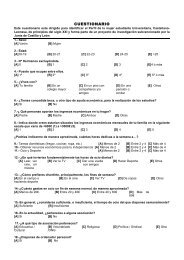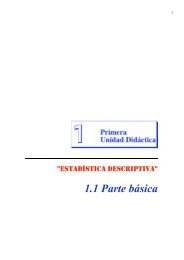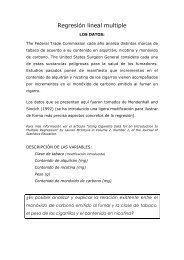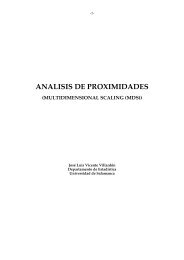Distribuciones de probabilidad - Estadística
Distribuciones de probabilidad - Estadística
Distribuciones de probabilidad - Estadística
You also want an ePaper? Increase the reach of your titles
YUMPU automatically turns print PDFs into web optimized ePapers that Google loves.
3.- El área <strong>de</strong>l recinto encerrado bajo la campana y el eje x es igual a la unidad.<br />
Por tratarse <strong>de</strong> una función <strong>de</strong> <strong>de</strong>nsidad. Y al ser simétrica, <strong>de</strong>ja igual área, 0,5, a<br />
la izquierda y a la <strong>de</strong>recha <strong>de</strong> la recta x = µ. Esto se verifica porque:<br />
+"<br />
# f(x) =<br />
!"<br />
haciendo el cambio <strong>de</strong> variable<br />
=<br />
%<br />
+$<br />
#$<br />
1<br />
! 2"<br />
#<br />
x ! µ<br />
" = y , entonces dx = σ dy, y por lo tanto<br />
+"<br />
!"<br />
e# y2<br />
2 !dy =<br />
1<br />
$ 2%<br />
!µ)2<br />
2$<br />
e!(x 2<br />
dx =<br />
1<br />
2"<br />
%<br />
+$<br />
#$<br />
y2<br />
# 2 e dy =<br />
1<br />
2"<br />
2" =1<br />
ya que la última integral, conocida como la integral <strong>de</strong> Gauss vale 2! , ya que:<br />
+" y2 !<br />
+"<br />
2 I = e dy = 2 e # !" # 0<br />
! y2<br />
2 dy = 2I1 y al multiplicar I1 por sí misma, y mediante métodos <strong>de</strong> integración doble, resulta su<br />
cuadrado igual a π/2.<br />
4.- Presenta puntos <strong>de</strong> inflexión en los puntos <strong>de</strong> abscisas µ + σ y µ - σ, don<strong>de</strong> cambia<br />
<strong>de</strong> concavidad (lo que <strong>de</strong>termina que cuánto mayor sea σ , más achatada sea la curva).<br />
El punto <strong>de</strong> inflexión se obtiene al igualar a cero la <strong>de</strong>rivada segunda, por lo tanto:<br />
(x " µ)2<br />
f'' (x) = 0 ! 1 "<br />
# 2<br />
= 0 !<br />
x " µ<br />
# = ±1! x = µ ± #<br />
Así, pues, presenta puntos <strong>de</strong> inflexión en los puntos x = µ + σ y en x = µ - σ,<br />
don<strong>de</strong> las coor<strong>de</strong>nadas <strong>de</strong> los puntos son: en x = µ + σ<br />
f(µ + !) =<br />
y en el punto x = µ - σ<br />
(µ +! #µ )2<br />
1<br />
2!<br />
e#<br />
! 2" 2<br />
=<br />
!2<br />
1 2!<br />
e#<br />
! 2" 2<br />
=<br />
1<br />
! 2" e# 1 2 =<br />
1<br />
! 2"e<br />
177









